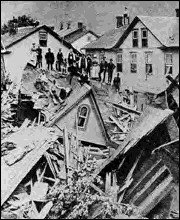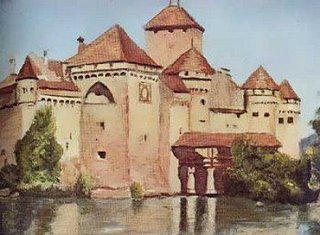
The topic of antique books came up recently in a conversation and got me thinking about my two "treasures":
The first is a wee 2" x 3" book I found in a box of sewing notions I inherited when my husband's maternal grandmother, an avid quilter, died. It's title:
Daily Texts, With Verses of Hymns: Adapted for General Use, and Suited for Every Year.
This tiny cloth-bound devotional book was published by the American Tract Society, but has no copyright year. However, the inscription inside the back cover reads, "Presented to Ralph Fleagle by his Great Aunt Anne Knox, March 24th, 1886." Ralph Fleagle was my husband's great uncle, no doubt a young boy at the time. The book is in excellent shape for being 120 years old and I just love this petite heirloom.
My other antique book was given to me by my dad some time back. I'm guessing he found it at Goodwill, one of his very favorite haunts. This book was published during the same period as my other little antique:
Johnstown Horror -- Valley of Death, was copyrighted in 1989, shortly after the events it describes. Dad gave me this particular book because of my special interest in the topic.
For nine years between 1977 and 1986, I lived in small communities close to Johnstown, Pennsylvania. My husband and I visited the Johnstown Flood Museum, drove the flood route from where the dam broke to the railroad bridge where the debris collected (30 acres worth!), and even had dinner with an elderly gentleman who survived the flood as a baby.

Because their town was situated at the fork of the Conemaugh and Stoneycreek Rivers in a valley in the Allegheny Mountains, the residents of Johnstown were accustomed to frequent flooding during heavy rains or rapidly melting snow. The townspeople were already moving their belongings to the second floor of their homes and businesses on May 31st,1989 due to the heavy rainfall that was filling the streets.
But this flood wasn't like the others: human neglect was to blame for the failure of the earthen dam fourteen miles upstream that created Lake Conemaugh, a 2 mile by 1 mile pleasure lake belonging to an elite fishing and hunting club. When the dam

gave way, a wall of water was unleashed that engineers have compared to the force of Niagra Falls, cascading down the valley toward the town 450 feet below. In the narrower parts of the valley, the wave rose to a horrific sixty feet high; it travelled at a whopping 40 mph. and was filled with trees, parts of houses and buildings, vehicles, animals and the unthinkable -- people. Several 8.5 ton locomotives were carried nearly a mile!
The Great Johnstown Flood was the
worst flood in our nation's history and was the greatest loss of American lives in a single day prior to September 11, 2001 -- 2,209 people lost their lives. It was the first major test of the newly formed Red Cross and it would be a full five years before the town recovered.
Johnstown experienced
another significant flood in 1936 which claimed two dozen lives and destroyed or severely damaged over 3,000 buildings. But the
Johnstown flood of 1977 is the one I recall personally:
On July 20, 1977, a thunderstorm stalled over Johnstown and its neighboring communities, dropping an incredible 11.82" in a ten-hour period. The National Weather Service has said that a rainfall of 7.32" would precipitate a "once in a thousand years' flood"; this torrential rainfall was enough to cause a "once in 5,000-10,000 years' flood"!
Six dams along along the converging rivers failed because they couldn't handle the overflow; neither could the area communities' sewer systems. Once again, with 128 million gallons of water crashing down the valley, floodwaters rose more than a story high at the center of town. This time the death toll reached 85, with property damage topping $300 million.
My husband had received a job transfer from South Dakota to Pennsylvania and we had just checked into a motel in Altoona, Pennsylvania (about 45 miles northeast of Johnstown) to spend our very first night in the Johnstown area -- July 20th. We would begin house-hunting the next day. During the night, thunder and very heavy rains woke us up, but we went back to sleep never imagining the devastation taking place. The next morning's front page was shocking!
Here's a link to the Johnstown Flood Museum's interesting
stories of survivors of the 1989 flood. They are told in a less sensational way than the accounts in my 500+ page antique book. The little bit of research I've done informs me that books of this kind written during the Victorian period were given to a sensational writing style, which explains why it reads something like a
National Inquirer story. Nevertheless, the sheer facts about the flood are both mind-boggling and sobering.
A time of catastrophe and tragedy but also a testimony to the triumph of human will.
 "Every great dream begins with a dreamer. Always remember, you have within you the strength, the patience, and the passion to reach for the stars to change the world."
"Every great dream begins with a dreamer. Always remember, you have within you the strength, the patience, and the passion to reach for the stars to change the world." 





















